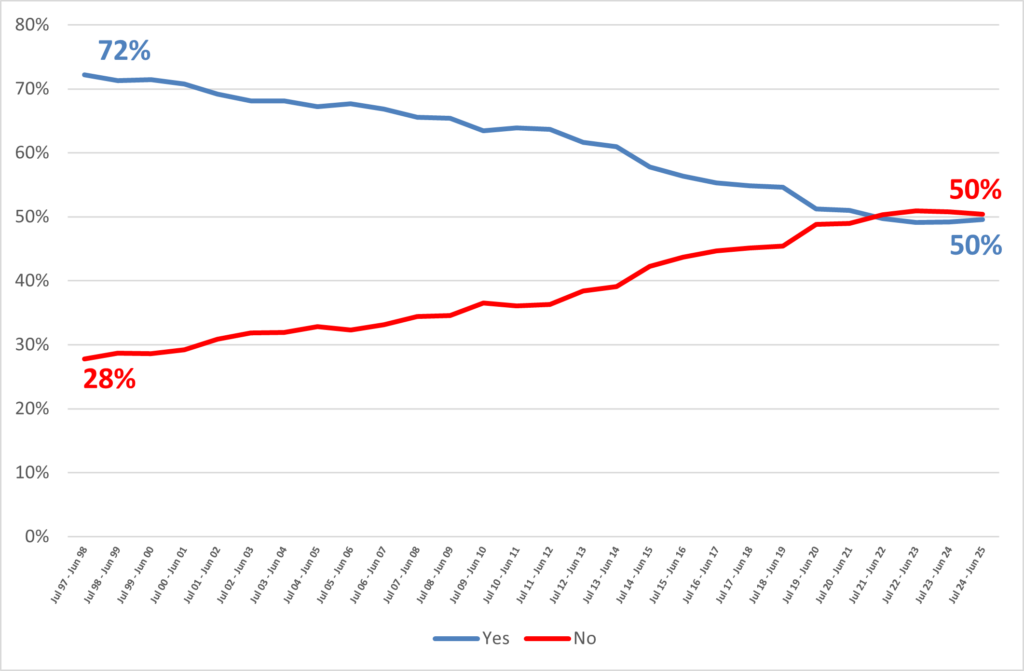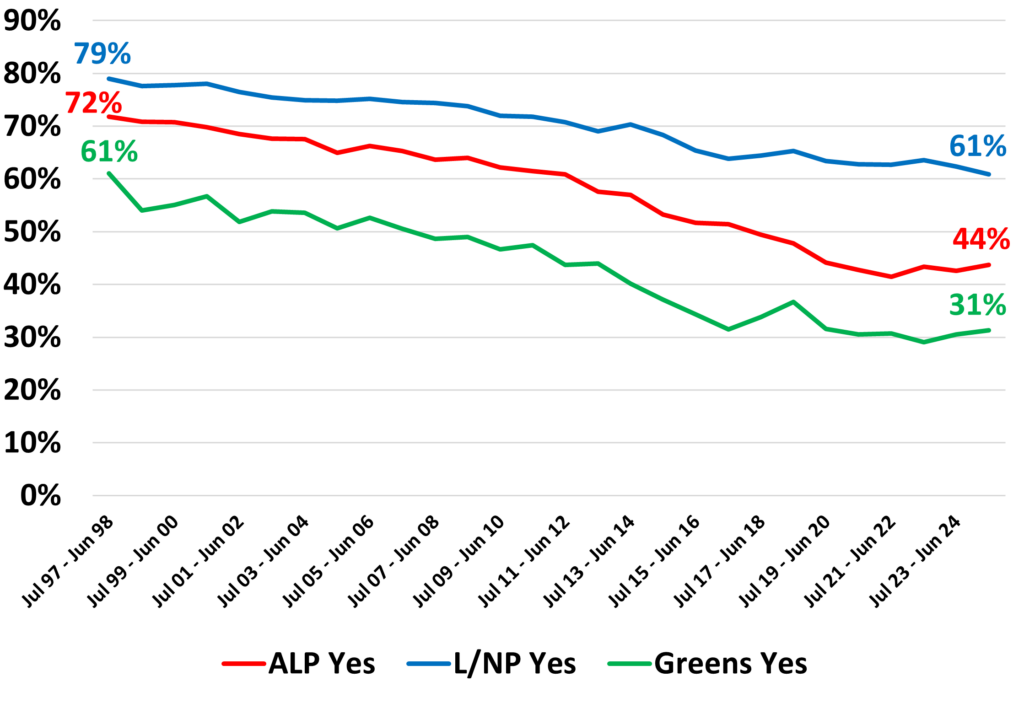Australians evenly split on teaching religion in government schools

New Roy Morgan research reveals a profound shift in Australian attitudes towards religious education in government schools, with support sitting evenly at 50% in favour and 50% opposed teaching religion at least once a week.
This represents a complete reversal of sentiment over a generation. In 1997–98, support for weekly religious instruction was overwhelming, with 72% of Australians in favour and just 28% opposed. Over the following two decades, support gradually eroded, slipping below 70% in the early 2000s and into the low-60s by the mid-2010s.
For the first time, support and opposition reached parity 2021-2022, marking a critical convergence. The trajectory then continued, with the "No" vote overtaking the "Yes" vote for the first time in the 2022–23 period, establishing a narrow majority of 51% to 49%. This shift from majority to minority support signalled the end of long-standing consensus. Support and opposition then held steady in 2023–24 at 51% to 49%.
In the year to June 2025, Australians are perfectly divided, with 50% opposing weekly religious teaching in government schools and 50% in favour.
The data highlight a significant cultural shift in Australia, reflecting growing secularisation, greater diversity of beliefs, and evolving expectations about the role of religion in public education.
Roy Morgan interviewed a representative cross section of 1,427,846 Australians aged 14+ from July 1997 to June 2025 who were asked: ‘Do you think religion should - or should not be taught at least once a week in Government schools?’
% of Australians: ‘Do you think religion should - or should not be taught at least once a week in Government schools?’

Source: Roy Morgan Single Source (Australia). Base: Australian, aged 14+ between July 1997 to June 2025, average interviews per year (n=50,994), total: (n=1,427,846).
Majority of Australians voters now oppose teaching religion in government schools
A majority of 51% of Australian electors now oppose the idea that religion should be taught at least once a week. In the late 1990s, Labor voters were strongly in favour, with 72% supporting religious education and only 28% opposed. Over the past two decades, however, support has collapsed. By 2024–25, fewer than half of ALP voters (44%) wanted religion taught weekly, while a majority (56%) were opposed. This represents a complete reversal of opinion among Labor supporters.
Coalition voters remain the strongest backers of religious education. Support has declined 18% points, from 79% in 1997–98 to 61% in 2024–25, but a clear majority still favour weekly religious instruction.
Greens voters have seen the steepest collapse in support, down 30% points. In 1997–98, a majority of 61% supported religious education and 39% opposed. By 2024–25, only 31% supported while 69% opposed, making Greens voters the most strongly against religion in schools. The tipping point occurred around 2008–09 when opposition overtook support.
One Nation voters have historically leaned heavily in favour. Support was 75% in the past 1990s, before slipping to 57% this year.
Independents/Other Minor Parties voters once are in line with the national average, with 70% support in 1997–98. Support has since fallen to just 48% in 2024–25, while opposition has risen to 52%, reflecting a majority now against.
These political differences underline how attitudes towards religion in education have fractured over time. What was once a broadly bipartisan consensus has evolved into a deeply partisan issue, with progressive voters strongly opposed, conservative voters largely supportive, and the balance of opinion among independents tipping against.
Support for religion being taught in government schools weekly by Party - 1997–2025

Source: Roy Morgan Single Source (Australia). Base: Australian electors, aged 18+ between July 1997 to June 2025, average interviews per year (n=42,469), total: (n=1,189,159).
Roy Morgan CEO Michele Levine says:

“Support for teaching religion in government schools has undergone a dramatic reversal over the past generation. In the late 1990s, nearly three-in-four Australians (72%) backed the idea, but today the nation is split evenly at 50/50.
“The national trend is mirrored in the political landscape, with Labor and Greens voters shifting decisively against, independents tipping more recently in line with the national average, and Coalition supporters now the only major voting bloc where a majority remain in favour.
“What was once a bipartisan consensus has become a deeply partisan divide that reflects Australia’s broader shift towards secularism and changing expectations about the role of religion in public life.”/
For comments or more information about Roy Morgan’s data please contact Andrew Calvert-Jones or Julian McCrann for more details.
Reports available for sale:
The latest Roy Morgan data is available on the Roy Morgan Online Store. It provides demographic breakdowns for Age, Sex, State, Region (Capital Cities/ Country), Generations, Lifecycle, Socio-Economic Scale, Work Status, Occupation, Home Ownership, Voting Intention, Roy Morgan Value Segments, Helix Personas, Media Consumption, and more
Related Research:
About Roy Morgan
Roy Morgan is Australia’s largest independent Australian research company, with offices in each state, as well as in the U.S. and U.K. A full-service research organisation, Roy Morgan has over 80 years’ experience collecting objective, independent information on consumers.
Margin of Error
The margin of error to be allowed for in any estimate depends mainly on the number of interviews on which it is based. Margin of error gives indications of the likely range within which estimates would be 95% likely to fall, expressed as the number of percentage points above or below the actual estimate. Allowance for design effects (such as stratification and weighting) should be made as appropriate.
| Sample Size | Percentage Estimate |
| 40% – 60% | 25% or 75% | 10% or 90% | 5% or 95% | |
| 1,000 | ±3.0 | ±2.7 | ±1.9 | ±1.3 |
| 5,000 | ±1.4 | ±1.2 | ±0.8 | ±0.6 |
| 7,500 | ±1.1 | ±1.0 | ±0.7 | ±0.5 |
| 10,000 | ±1.0 | ±0.9 | ±0.6 | ±0.4 |
| 20,000 | ±0.7 | ±0.6 | ±0.4 | ±0.3 |
| 50,000 | ±0.4 | ±0.4 | ±0.3 | ±0.2 |
